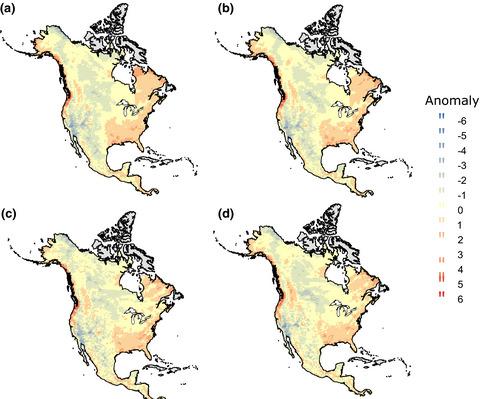当前位置:
X-MOL 学术
›
Ecol. Evol.
›
论文详情
Our official English website, www.x-mol.net, welcomes your feedback! (Note: you will need to create a separate account there.)
Comparison of environmental inference approaches for ecometric analyses: Using hypsodonty to estimate precipitation
Ecology and Evolution ( IF 2.6 ) Pub Date : 2020-12-04 , DOI: 10.1002/ece3.7081 Rachel A. Short 1 , Katherine Pinson 2 , A. Michelle Lawing 1
中文翻译:

进行生态计量分析的环境推断方法的比较:使用催眠估计降水
更新日期:2021-01-08
Ecology and Evolution ( IF 2.6 ) Pub Date : 2020-12-04 , DOI: 10.1002/ece3.7081 Rachel A. Short 1 , Katherine Pinson 2 , A. Michelle Lawing 1
Affiliation

|
- Ecometrics is the study of community‐level functional trait–environment relationships. We use ecometric analyses to estimate paleoenvironment and to investigate community‐level functional changes through time.
- We evaluate four methods that have been used or have the potential to be used in ecometric analyses for estimating paleoenvironment to determine whether there have been systematic differences in paleoenvironmental estimation due to choice of the estimation method. Specifically, we evaluated linear regression, polynomial regression, nearest neighbor, and maximum‐likelihood methods to explore the predictive ability of the relationship for a well‐known ecometric dataset of mammalian herbivore hypsodonty metrics (molar tooth crown to root height ratio) and annual precipitation. Each method was applied to 43 Pleistocene fossil sites and compared to annual precipitation from global climate models. Sites were categorized as glacial or interglacial, and paleoprecipitation estimates were compared to the appropriate model.
- Estimation methods produce results that are highly correlated with log precipitation and estimates from the other methods (p < 0.001). Differences between estimated precipitation and observed precipitation are not significantly different across the four methods, but maximum likelihood produces the most accurate estimates of precipitation. When applied to paleontological sites, paleoprecipitation estimates align more closely with glacial global climate models than with interglacial models regardless of the age of the site.
- Each method has constraints that are important to consider when designing ecometric analyses to avoid misinterpretations when ecometric relationships are applied to the paleontological record. We show interglacial fauna estimates of paleoprecipitation more closely match glacial global climate models. This is likely because of the anthropogenic effects on community reassembly in the Holocene.
中文翻译:

进行生态计量分析的环境推断方法的比较:使用催眠估计降水
- 经济计量学是研究社区级功能特征与环境之间的关系。我们使用生态计量分析来估计古环境,并调查随时间推移的社区级功能变化。
- 我们评估了四种已经或可能在生态学分析中用于估计古环境的方法,以确定是否由于选择了估计方法而在古环境估计中存在系统差异。具体来说,我们评估了线性回归,多项式回归,最近邻法和最大似然法,以探讨该关系对哺乳动物食草动物高度重视度度量标准(摩尔齿冠与牙根高度比)和年降水量的关系的预测能力。 。每种方法都应用于43个更新世的化石遗址,并与全球气候模型的年降水量进行了比较。站点被分类为冰期或冰间期,并且将古降水估计与适当的模型进行了比较。
- 估计方法产生的结果与对数降水高度相关,而其他方法的估计值也与此相关(p <0.001)。在这四种方法中,估计的降水量与观测到的降水量之间的差异没有显着差异,但是最大似然会产生最准确的降水量估算。当应用于古生物学遗址时,无论该遗址的年龄如何,古降水估计与冰川全球气候模型的一致性要比冰川间气候模型的一致性高。
- 每种方法都有一些约束条件,这些约束条件在设计生态计量分析时要加以考虑,以避免在将生态计量关系应用于古生物学记录时避免产生误解。我们显示古降水的冰川间动物区系估计更接近冰川全球气候模型。这可能是由于全新世的人类活动对社区重组的影响。



























 京公网安备 11010802027423号
京公网安备 11010802027423号